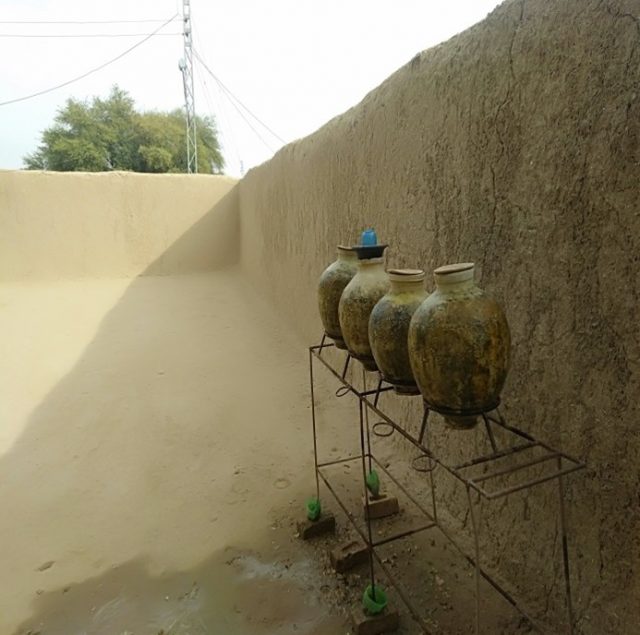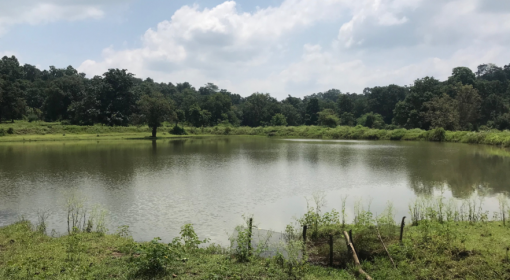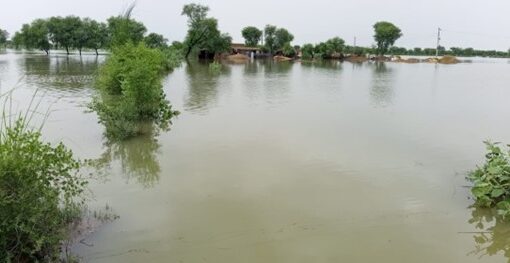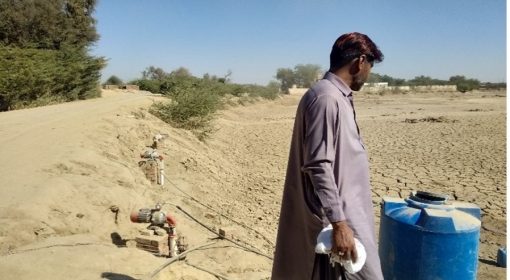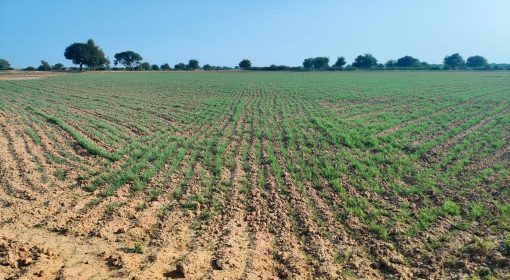By Allah Bakhsh, with contribution from Reinier Veldman (Flood Based Livelihoods Network)
February 5, 2021
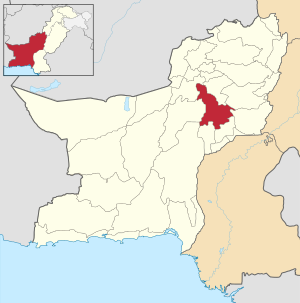
The Kacchi plain is a dry and arid terrain spanning the Jhal Magsi and Bolan districts in Balochistan province of Pakistan. The entire plain has no fresh groundwater, except the piedmont parts of plains closer to the Kirthar mountain range in the west.
The main source of drinking and irrigation water are seasonal floods, which occur mostly during the monsoons in July-August and occasionally in winter months. Some rivers which touch the highlands run through part of the catchment.
Drinking water ponds
There are hundreds of small to medium-sized villages in the plain that catch flood water, and use them for irrigation and for filling of drinking water ponds. Most of them have 1-2 drinking water ponds of different sizes, for domestic and livestock use. They are filled up using floodwaters during every flood event. Most of these drinking water ponds are connected with the local canals used for irrigation in various parts of the villages in the plain. The ponds are filled with natural flows and occasionally through pumping by tractors. There are 2 big reservoirs serving Bhag Town that have their own canals and a separate ganda (earthen bunds constructed across the river) on Nari River to divert water to fill these reservoirs. The costs of constructing gandas and maintaining canals is paid by the local municipal committee of Bhag town every year.
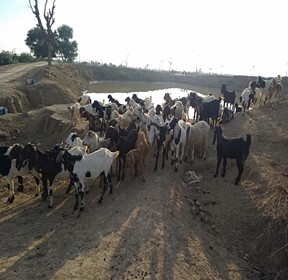
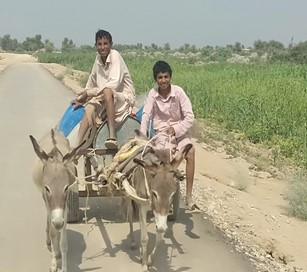
In many villages reservoirs are constructed a bit away from the villages to minimize intrusion by pets and livestock. Almost every household living in a village outside Bhag town has donkeys which are used for fetching water, and transporting fodder for animals and firewood for the household. In Bhag town there are dozens of water carriers who deliver water at people’s doorsteps for Rs.50 ($0.35) per load, as long as the water is available in the pond. One load is about 160-200 litres of water in an iron container fixed on two-wheel carts pushed by donkeys.
The ponds do not sustain these communities for more than 3-6 months, depending on the weather and evaporation. Usually, they start drying in the month of April every year if there are no floods. This year the area has received a number of floods in April and all ponds are filled. Nevertheless, due to the summer heat, they will hardly survive for much longer before the monsoons.
Mini-barrages
The recently constructed mini-barrages on the Narri river create an opportunity to give priority to the filling of drinking water ponds when the first floods arrive. The operation of the mini-barrages enables a better control of the floods, compared to earthen dams that stood in their places before. The individual gates of the barrage can be set to allow a share of the flood to flow downstream to fill the ponds; as opposed to past practice of using earthen dams to block the flow of the floods until they broke. This will lead to an improvement in the availability of drinking water. The role of the Newarbi project is to ensure that these priority arrangements are embedded in the water allocation arrangements.
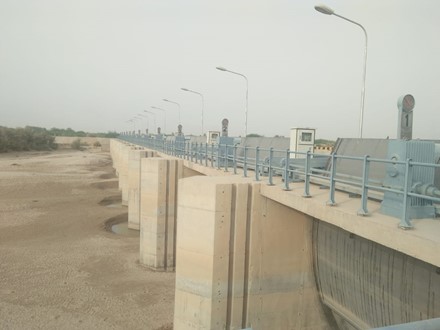
In the absence of floods almost all economically poor households go to the Nari River bed and excavate open surface wells to collect seepage water. Sometime these wells go beyond 20ft deep and often collapse. The donkey carts drivers also dig their wells in the river bed to extract the water that they need to continue their business. During such dry periods, the cost of each donkey load rises to Rs: 300 ($2.00/trip).
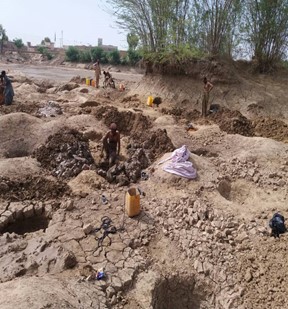
Tractor tankers also operate in the area. Well-to-do households normally place their orders for entire tankers as they have big cemented tanks in their compounds. Tractors charge Rs: 700 ($5,00) per trip when they bring water from the nearby pond. They also fetch water from parts of Nari river bed that have depressions that hold water released by barrages during the dry season. In the upper part of Nari near Haji Shahr village, rich households have now excavated shallow tube wells that are used for drinking purpose. Local residents say that the groundwater table has risen after construction of barrages as there is likely an increased infiltration of water into the aquifer.
There is no significant protection of ponds by fencing or walls. Some ponds are surrounded by brick walls, particularly those lying closer to the habitation. Local people are of the opinion that water remains clean for longer since wind creates ripples in the water which they believe gets rid of some of the impurities. Some ponds turn brackish after acacia tree leaves and branches fall in them. They are then fit only for animal drinking and for use in construction of mud walls. People treat such water with Alum, which settles the turbidity and kills the bacteria
Seasonal migration
Many villages in Kacchi plain have constructed cemented open water tanks that are filled by the tractors when there is no water in the pond. Migration for water in rural areas is common, especially among farmers during the summer months. For example, villages living in the plain in Jhal Magsi district migrate to Gandawa, Gajan, and Patri, Pach villages where perennial flow of Mula River is available, with the water passing through villages through constructed canals. There are trees along the canal that provides shadow to the cattle and humans. They stay there for 2-3 months until the floods, following which they go back to their villages in the plains. Others migrate to big villages in the area where water is available in the ponds for longer time. Some households also migrate to the Pat-feeder canal area just to have water during the critical summer period.
Permanent and seasonal migration to the big cities like Quetta, Hab Chowki, Mastung, Karachi and Sibi is also common especially among well-to-do families who migrate to ensure better education for their kids and others just trying to escape the warm weather. They run small businesses in these cities but maintain close contact with their native areas as well.
Water sharing arrangements and other practices
There are no restrictions on fetching of water from any pond by anyone in the area as water is a basic need and morality does not allow imposing such restrictions on humans and animals. Not all the residents have constructed tanks in their households. They fetch water on a daily basis and store the water in plastic cans for drinking and domestic use. Animals are taken to the ponds approximately twice a day during summer months.
The nomads coming to the area in winter months share these very ponds with the villagers. Routine maintenance and de-silting of the ponds is done by the inhabitants of these villages, who contribute labour and cash. Sometimes some villages are also able to source some funding for this purpose from the local members of the provincial assembly (MPs).
A majority of the local population use water pitchers made out of baked mud to store drinking water at home. These pitchers keep the water cool, which is important in these areas where many cannot afford refrigerators and are not connected to the power grid.
